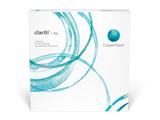Latest Addition to Consumer Insights Series Surveyed >8,000 People in Eight Countries;
Shows Importance of Educating Patients About All Vision Correction Options
SAN RAMON, Calif., July 13, 2021—CooperVision’s latest Consumer Insights Series report points to the opportunity for eye care professionals (ECPs) to further educate patients on all relevant vision correction methods, including dual use of contact lenses and glasses (spectacles). The research synopsis—which includes straightforward suggestions for ECPs on how to make use of these new insights—is now available for download at https://coopervision.com/practitioner/dual-wearer-report.
A survey commissioned by CooperVision and conducted by YouGov queried more than 4,000 dual wear and 4,000 spectacle-only wearers across Australia, Canada, Italy, Japan, the Netherlands, Sweden, the United Kingdom, and the United States. The results show that a significant number of spectacle-only wearers may not have the full picture about contact lenses or are waiting for their ECP to recommend them.
The study summarizes common barriers that make spectacle-only wearers hesitant to try contact lenses—most of which can be addressed by ECPs. Patients rely on their ECP to suggest alternative forms of vision correction, with about one in five respondents stating they started wearing contact lenses because of their ECP’s recommendation. Another 23% of respondents were unaware that contact lenses were even available for their prescription.
When asked about the advantages of their vision correction approach, only one-third (32%) of spectacle-only wearers agreed that their glasses were comfortable and just 26% said their glasses formed “part of their personality.” In contrast, 52% of dual wearers stated they liked the way they look in contact lenses and 58% appreciated that their contact lenses did not fog up or get dirty.
ECPs have the opportunity to take a proactive approach in discussing wearing both contact lenses and glasses by raising common patient lifestyle choices. More than half (54%) of dual wearers began using contact lenses because they found spectacles inconvenient for certain activities like exercising. Another 37% started because they did not like the way they looked in spectacles.
The comparison between spectacle-only and dual-wear respondents demonstrates the knowledge gap of contact lenses’ advantages for certain activities. This insight presents a good opportunity for ECPs to routinely ask patients about their lifestyle and activities and point out contact lens wear benefits specific to those factors. The report also stresses the importance for ECPs to create a tangible, on-eye trial experience for patients, as the benefits of contact lenses may be hard to imagine for someone who’s never tried them.
“A lack of ECP recommendations is one of the main reasons patients don’t consider contact lenses for their vision correction. By helping more people understand that they can wear contact lenses, ECPs can further deepen their relationships and increase their value as a trusted advisor in caring for their patients. This includes explaining that glasses and contact lenses do not have to be an ‘either-or’ choice, but can co-exist,” said Gary Orsborn, OD, vice president of Global Professional, Medical and Clinical Affairs for CooperVision. “By understanding the insights outlined in this study—and more routinely discussing patients’ vision correction options—ECPs can help to bridge gaps in knowledge and misperceptions of spectacle-only wearers. Doing so has the potential to create better experiences for their patients as well as enhanced opportunities for their practice.”
The Consumer Insights Series report recommends that ECPs take three steps to encourage spectacle-only wearers to consider contact lenses: be proactive; make it personal; and get lenses on eyes. More detailed suggestions are incorporated within the downloadable report.
# # #
About CooperVision
CooperVision, a division of CooperCompanies (NYSE:COO), is one of the world’s leading manufacturers of contact lenses. The company produces a full array of daily disposable, two-week and monthly soft contact lenses that feature advanced materials and optics, and premium rigid gas permeable lenses for orthokeratology and scleral designs. CooperVision has a strong heritage of addressing the toughest vision challenges such as astigmatism, presbyopia, childhood myopia, and highly irregular corneas; and offers the most complete portfolio of spherical, toric and multifocal products available. Through a combination of innovative products and focused practitioner support, the company brings a refreshing perspective to the marketplace, creating real advantages for customers and wearers. For more information, visit www.coopervision.com.
About CooperCompanies
CooperCompanies ("Cooper") is a global medical device company publicly traded on the NYSE (NYSE:COO). Cooper operates through two business units, CooperVision and CooperSurgical. CooperVision brings a refreshing perspective on vision care with a commitment to developing a wide range of high-quality products for contact lens wearers and providing focused practitioner support. CooperSurgical is committed to advancing the health of women, babies and families with its diversified portfolio of products and services focusing on medical devices and fertility & genomics. Headquartered in San Ramon, Calif., Cooper has a workforce of more than 12,000 with products sold in over 100 countries. For more information, please visit www.coopercos.com.
Media Contact
Mike McDougall, APR, Fellow PRSA, McDougall Communications
mike@mcdougallpr.com or +1-585-434-2150





